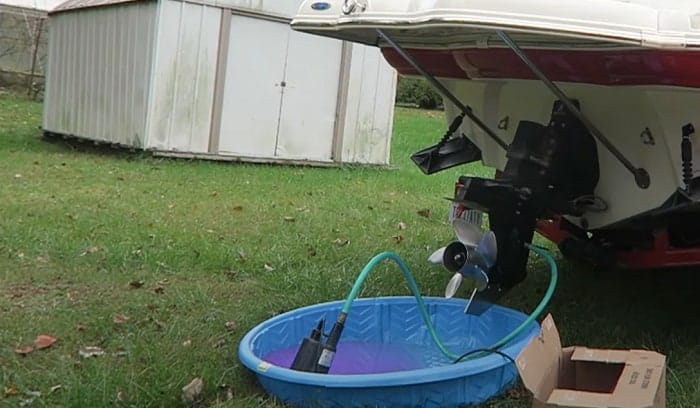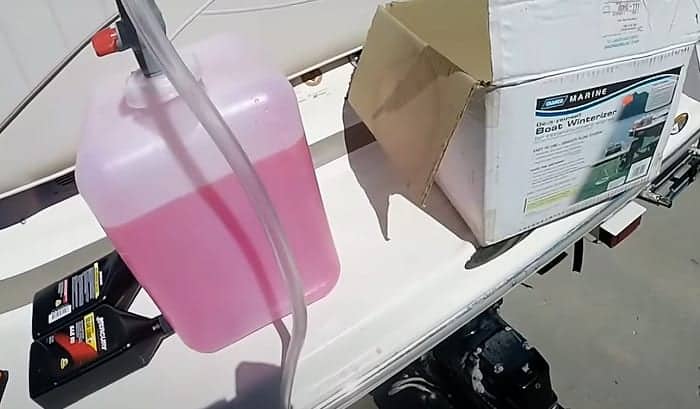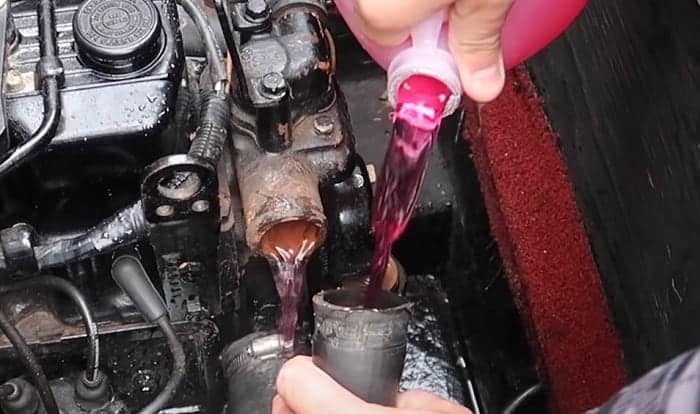Winter is a harsh season, and its effects on your boat can be devastating. Since you invested a lot in your boat, it goes without saying that you need to keep it in good condition. However, professional winterization is expensive, and doing it yourself is complicated, or is it?
We will take you through the simplest and easiest way to go about preparing your boat for winter storage. We’ll cover the process to winterize inboard boat motor as well, so keep reading and learn how to winterize an inboard boat, the easy way.
Table of Contents
- What You’ll Need
- How to Winterize an Inboard Boat
- Step 1. Check your manual for special instructions
- Step 2. Fill the tank with fuel & apply stabilizer
- Step 3. Let the engine run
- Step 4. Drain all liquid from the engine
- Step 5. Run antifreeze through the water intake & spray the fogging oil
- Step 6. Perform the necessary boat maintenance
- Step 7. Dry the whole boat
- Conclusion
What You’ll Need
- Water hose
- Water source; a faucet will do
- Inboard motor flusher; also called muffs
- Antifreeze; around 5 gallons
- Container for the antifreeze
- Fogging oil spray
- Screwdriver
- Anti-corrosive or anti-rust spray
- Cleaning cloth
- Cleaning Materials (optional):
- Boat carpet cleaner
- Vacuum cleaner
- Cleaning brush
- Deck brush
- Soap
- Polish
How to Winterize an Inboard Boat
Step 1. Check your manual for special instructions
First, check the manuals for your boat and engine. There will usually be a section in the manual for winterization; look for special instructions that could be unique to your boat or its engine. Failing to follow special instructions could risk damage to your boat, so look carefully.
Also, take the time to go over instructions for your winterization materials, pay close attention to the muffs. It’s simple and easy to use, but improper use of the muffs can cause significant problems to your engine, so be careful when using it.
After making sure that you’ve checked everything, it’s time to prepare your boat for winterizing. It’s recommended to have your oil changed before storing it, but you don’t have to do it if you’ve already had it done a few months prior. It’s also recommended to change your oil and fuel filters, though this too is optional.
Get your boat out of the water and let’s get the process started. It’s fine to start winterizing with the boat on a trailer.
Step 2. Fill the tank with fuel & apply stabilizer
The next step is to fill your fuel tank with fuel; it is recommended to have it full. You can fill it before or after taking it out of the water. Filling the fuel tank with fuel keeps air out of the tank which can cause damage during the winter. Leave just a bit of space for the fuel’s expansion once the weather warms.
After the tank is filled, apply the stabilizer to the tank. You should check the packaging for the right proportion, but an ounce of stabilizer is usually enough for 10 gallons of fuel. The stabilizer is used to keep the fuel fresh and will allow it to combust once winter is over.
Next, we’ll prepare to run the boat engine out of the water.
Step 3. Let the engine run
Attach your water hose to a water source, then attach the other side to your motor flusher or muff. Secure your muff to the water intake of your boat, make sure that it is secured tightly because the loss of water to the intake will seriously hurt your engine.
Make sure that water is running through the muff before turning the engine on. Turn the engine on only when you have confirmed that water is running. After the engine starts running, keep an eye on the boat’s rpm and temperature.
You need to keep the engine running below 1500 rpm. This is because running at a higher rpm will demand more water, which your hose will not be able to supply. As for the temperature, you’ll want to have it go up to the level that you usually reach when running your boat on the water.
After reaching the target temperature, turn the engine off then turn the water off.
Step 4. Drain all liquid from the engine
Get to your engine and drain all the liquid from it. You need to look for petcocks on your engine, they look like knobs similar to those found on valves or some faucets. These petcocks can be screwed off to drain the liquid from the engine. You’ll need to look for 2 or more, and the manual should specify the location of each.
Aside from the engine, you may also need to drain water from other plumbing sections of your boat. Again, refer to your manual for these. You may also have a separate cooling system on your engine which also needs to be drained. You won’t have to worry about anything else other than draining these.
After draining the liquid from your engine, make sure also to clean the petcocks. There should also be a rubber seal that keeps the petcock sealed tight; make sure to secure these in place when screwing the petcocks back on.
Since the engine warmed up from running, it’s normal for the liquid draining from the engine to be steamy. Don’t be surprised by it, it’s normal.
Step 5. Run antifreeze through the water intake & spray the fogging oil
Before we continue to winterize an inboard motor, prepare your antifreeze and put it into your container. 5 gallons should be enough for your engine but if you have any extra plumbing, you’ll need some for those as well. Now have a hose running from your muffs to this container; we’ll have the intake pick up the antifreeze instead of water.
Use a different hose for the antifreeze. The one we used earlier will have leftover water and it’s important to keep water out of the engine at this point.
After putting everything in place, it’s time to turn on the engine again. Let the engine run until you see antifreeze flowing out of the boat’s exhaust. Once this happens, let it run for 10 to 20 seconds more.
Take your fogging oil spray and remove your carburetor cover, spray the fogging oil spray into the carburetor. Keep spraying until the engine stalls. The fogging oil will give a protective coat to the carburetor to protect it from rust.
Don’t forget to actually turn the engine off, and to detach the muffler from the boat.
Step 6. Perform the necessary boat maintenance
Now it’s time to go over the rest of the boat, but remove your battery from the boat first. It’s better to perform necessary maintenance on your boat at this point, before winter storage. Removing stains, for instance, will be unnecessarily difficult after storing, so it’s better to attend to them sooner.
Maintenance includes repainting, carpet cleaning or replacement, and even furniture maintenance. Additionally, you should apply anti-corrosive to any unpainted areas of the boat to keep rust and corrosion from appearing. A thorough cleaning is recommended.
It’s also necessary to clean the exterior of the boat. After cleaning, apply some polish to protect it from dirt and dust. It’s also recommended to remove cushions and upholstery from the boat if possible.
Step 7. Dry the whole boat
The final step is to check that everything is in order and that everything is dry. Be sure that none of the liquid from draining the engine remains. These will cause significant damage, more than you can imagine, so try to be as thorough as possible.
Once you’ve checked that everything is dry, it’s time to cover everything up and you’re all set for winter storage.
Pro Tips:
- Fully charge your battery before storing but store it indoors.
- Keep the engine cover open for extra ventilation.
- Consider placing a dehumidifier to protect against mold and mildew.
- Put some insect repellant and mothballs inside the boat.
- If your boat has more than one engine, winterize them all.
Conclusion
This ends our short guide on how to winterize an inboard boat the easy way. After going through this guide, you will hopefully feel confident about storing your boat for the winter and have saved some money as well.
Winterizing inboard boats is extremely important, and doing it yourself should be a valuable experience for any boat owner. Hopefully, it was as enjoyable to you as it was to me.
Did you find this guide helpful? Please leave your comments below as we’d love to hear from you. Also please share this guide with your friends. Boat safely!

“I am James Harvey – founder of Boating Basics Online. It is established with the drive to help out first-time boaters, which are those desiring to explore their way through the water. So if you are new to boating, start from here with me. “



